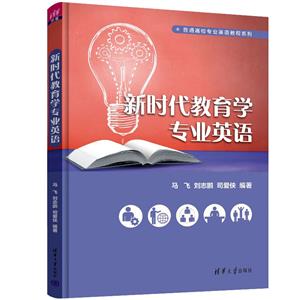包郵 新時(shí)代教育學(xué)專(zhuān)業(yè)英語(yǔ)
-
>
妙相梵容
-
>
基立爾蒙文:蒙文
-
>
我的石頭記
-
>
心靈元?dú)馍?/p>
-
>
女性生存戰(zhàn)爭(zhēng)
-
>
縣中的孩子 中國(guó)縣域教育生態(tài)
-
>
(精)人類(lèi)的明天(八品)
新時(shí)代教育學(xué)專(zhuān)業(yè)英語(yǔ) 版權(quán)信息
- ISBN:9787302609582
- 條形碼:9787302609582 ; 978-7-302-60958-2
- 裝幀:一般膠版紙
- 冊(cè)數(shù):暫無(wú)
- 重量:暫無(wú)
- 所屬分類(lèi):>>
新時(shí)代教育學(xué)專(zhuān)業(yè)英語(yǔ) 本書(shū)特色
本書(shū)內(nèi)容緊扣“經(jīng)典實(shí)用”和“*新科技”兩大主題,教材編寫(xiě)貫穿內(nèi)容和語(yǔ)言相結(jié)合的教學(xué)思想(CLIL),讓學(xué)生在學(xué)習(xí)語(yǔ)言的同時(shí)掌握*經(jīng)典*新穎的教學(xué)理念。
新時(shí)代教育學(xué)專(zhuān)業(yè)英語(yǔ) 內(nèi)容簡(jiǎn)介
本書(shū)旨在切實(shí)提高讀者的專(zhuān)業(yè)英語(yǔ)能力和教育教學(xué)理論水平。全書(shū)共12個(gè)單元,第1至第7單元主要介紹教育學(xué)領(lǐng)域的經(jīng)典及常用理論,如行為主義理論、認(rèn)知主義理論、建構(gòu)主義理論等;第8至第12單元主要介紹現(xiàn)代信息技術(shù)對(duì)教學(xué)的影響,如互聯(lián)網(wǎng)、大數(shù)據(jù)、虛擬仿真、創(chuàng)客、云計(jì)算、人工智能等在教學(xué)中的運(yùn)用。本書(shū)還配有豐富的教學(xué)資源(含電子課件和習(xí)題答案),方便讀者進(jìn)行教學(xué)和自主學(xué)習(xí)。 本書(shū)既可作為本科和專(zhuān)科院校教育學(xué)相關(guān)專(zhuān)業(yè)的專(zhuān)業(yè)英語(yǔ)教材,也可供從業(yè)人員自學(xué)。作為教學(xué)培訓(xùn)教材,亦頗得當(dāng)。
新時(shí)代教育學(xué)專(zhuān)業(yè)英語(yǔ) 目錄
Unit 1
Text A Behavioral Learning Theory 1
Text B Behaviorism in Classroom 6
Supplementary Reading The Audio-lingual Method 12
參考譯文(Text A) 行為主義學(xué)習(xí)理論 16
Unit 2
Text A Cognitive Theories of Learning 19
Text B Cognitivism in the Classroom 25
Supplementary Reading Using Cognitive Psychology in the Classroom: Approach with Caution 30
參考譯文(Text A) 認(rèn)知主義學(xué)習(xí)理論 33
Unit 3
Text A Constructivist Learning Theory 37
Text B Constructivism Teaching Approaches 43
Supplementary Reading Instruction Design of Behaviorism, Cognitivism and Constructivism 49
參考譯文(Text A) 建構(gòu)主義學(xué)習(xí)理論 52
Unit 4
Text A Intrinsic and Extrinsic Motivation 55
Text B Theories of Motivation 61
Supplementary Reading Motivating Students in the Foreign Language Classroom 65
參考譯文(Text A) 內(nèi)在動(dòng)機(jī)和外在動(dòng)機(jī) 71
Unit 5
Text A Effective Learning Strategies 75
Text B Thinking About Thinking: Metacognition 82
Supplementary Reading Six Learning Strategies You Should Share with Students 86
參考譯文(Text A) 有效的學(xué)習(xí)策略 91
Unit 6
Text A Learner Autonomy as an Educational Goal 95
Text B Autonomy in the Foreign Language Classroom 101
Supplementary Reading Autonomous Learner Model 107
參考譯文(Text A) 教育目標(biāo)之自主學(xué)習(xí) 112
Unit 7
Text A Transfer of Learning 115
Text B Lessons for Life: Learning and Transfer 121
Supplementary Reading Ten Ways to Improve Transfer of Learning 126
參考譯文(Text A) 學(xué)習(xí)遷移 130
Unit 8 Text A How the Internet Changes How We Learn 133
Text B Pitfalls of Online Learning 138
Supplementary Reading Ten Things to Know About MOOCs 143
參考譯文(Text A) 互聯(lián)網(wǎng)如何改變我們的學(xué)習(xí)方式 146
Unit 9
Text A Big Data in the Classroom 149
Text B Big Data in eLearning 154
Supplementary Reading Big Data: How Analytics Benefits Higher Education 158
參考譯文(Text A) 課堂中的大數(shù)據(jù) 161
Unit 10 Text A When VR Meets Education 165
Text B Five VR Trends to Watch in Education 170
Supplementary Reading How VR Can Close Learning Gaps in Your Classroom 174
參考譯文(Text A) 當(dāng)虛擬現(xiàn)實(shí)邂逅教育 177
Unit 11 Text A Artificial Intelligence in Education 181
Text B The Education Cloud: Delivering Education as a Service 187 Supplementary Reading How Teachers See the Classroom Redefined by the Cloud 193
參考譯文(Text A) 教育中的人工智能 196
Unit 12 Text A Bringing the Maker Movement to the Classroom 201
Text B NuVu Studio as a Makerspace 206
Supplementary Reading How Technology Is Shaping the Future of Education 211
參考譯文(Text A) 將創(chuàng)客運(yùn)動(dòng)帶入課堂 214
新時(shí)代教育學(xué)專(zhuān)業(yè)英語(yǔ) 作者簡(jiǎn)介
馬飛,男,1977年生,副教授,博士在讀,現(xiàn)為浙江萬(wàn)里學(xué)院大學(xué)外語(yǔ)教學(xué)部副主任。1999年畢業(yè)于西安外國(guó)語(yǔ)大學(xué),2007年獲上海外國(guó)語(yǔ)大學(xué)碩士學(xué)位,預(yù)計(jì)于2018年6月獲諾丁漢大學(xué)教育學(xué)博士學(xué)位。2016年訪學(xué)英國(guó)諾丁漢大學(xué)。在國(guó)內(nèi)外刊物上發(fā)表論文十余篇,出版教材教輔用書(shū)三部,期中一部為2016年清華大學(xué)出版社出版的《旅游專(zhuān)業(yè)英語(yǔ)實(shí)用教程》。
- >
唐代進(jìn)士錄
- >
伯納黛特,你要去哪(2021新版)
- >
【精裝繪本】畫(huà)給孩子的中國(guó)神話
- >
月亮與六便士
- >
李白與唐代文化
- >
姑媽的寶刀
- >
中國(guó)歷史的瞬間
- >
隨園食單

















